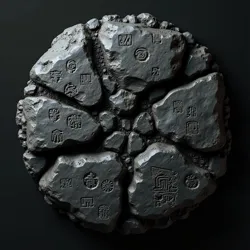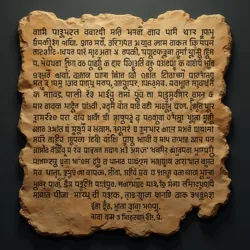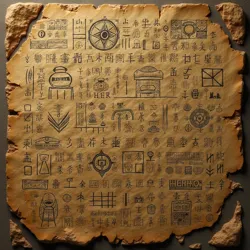Fragments of Anthracite

Dense coal like fragments marked with intricate indecipherable inscriptions, purported source of writings by Herizhon the Unseen.
anthracite
Herizhon's Cryptoglyphs
Herizhon the Unseen
Obsidian Dynasty
Paleo-Semiotics, Cryptic Linguistics
Order of Silent Scribes
Monastery of Ephemeral Scrolls
understand lost languages
*Fragments of Anthracite are a collection of enigmatic artifacts, characterized by their composition of a dense, coal-like substance marked with intricate, indecipherable inscriptions. These fragments are primarily known as the purported source of the surviving writings attributed to the shadowy figure known as Herizhon the Unseen, a scholar of considerable, albeit apocryphal, renown associated with the twilight years of the Obsidian Dynasty. Revered and scrutinized in equal measure by scholars of Paleo-Semiotics and Cryptic Linguistics, the Fragments are considered to be of paramount importance in the ongoing quest to understand the nature of lost languages and the theoretical Cipher of Lost Tongues*.
Origin and Discovery
The precise origins of the Fragments of Anthracite remain shrouded in mystery and academic debate, much like the figure of Herizhon himself. No definitive archaeological context has ever been established for their discovery, and accounts of their initial appearance vary wildly, often interwoven with myth and speculation. Some narratives suggest that the fragments were unearthed from the ruins of a Pre-Obsidian Dynasty settlement, a civilization swallowed by the sands of time and forgotten by subsequent epochs. Others posit a more esoteric origin, claiming that the fragments were not 'discovered' in the conventional sense, but rather 'revealed' or 'manifested' through means that defy contemporary understanding.
 Mysterious origins of the Fragments debated by scholars, with narratives ranging from pre-Obsidian Dynasty ruins to esoteric revelations.
Mysterious origins of the Fragments debated by scholars, with narratives ranging from pre-Obsidian Dynasty ruins to esoteric revelations.Geological Composition
Despite the uncertainty surrounding their discovery, the physical nature of the Fragments of Anthracite is relatively consistent across all known specimens. Analysis reveals that the material is indeed a form of anthracite, a high-rank coal known for its density, hardness, and lustrous black appearance. However, unlike naturally occurring anthracite deposits found in geological strata, the Fragments exhibit several anomalous properties. Their density is significantly greater than typical anthracite, approaching that of certain metamorphic rocks, and they display an unusual resistance to heat and pressure. Furthermore, microscopic examination reveals a crystalline structure within the anthracite matrix that is not consistent with geological formation processes, suggesting an artificial or alchemical alteration of the material.
Some scholars have speculated that the anthracite used in the Fragments might have been subjected to an unknown process of refinement or treatment during the Obsidian Dynasty era, potentially involving techniques now lost to time. The Obsidian Dynasty was known for its mastery of esoteric crafts and arcane technologies, and it is conceivable that they possessed the knowledge to manipulate materials at a fundamental level, imbuing them with properties beyond their natural state. This hypothesis aligns with the dynasty's reputation for creating artifacts of extraordinary resilience and enigmatic purpose, such as the Obelisk of Shadows and the Crown of Azurnath, both objects exhibiting material characteristics that defy conventional explanation.
The Obsidian Dynasty Connection
The association of the Fragments of Anthracite with the Obsidian Dynasty, and specifically with Herizhon the Unseen, is primarily based on textual evidence and scholarly tradition. The inscriptions found on the fragments are written in a script that, while sharing some superficial similarities with known Obsidian Dynasty glyph systems, exhibits unique characteristics that set it apart. This script, often referred to as "Herizhon's Cryptoglyphs," is characterized by its intricate, curvilinear forms and its apparent resistance to conventional decipherment methods.
The earliest documented references to the Fragments appear in the archives of the Order of Silent Scribes, a reclusive academic society dedicated to the study of Paleo-Semiotics and esoteric knowledge. According to the Order's annals, the Fragments first came to their attention during the Cycles of Unveiling, a period of intense intellectual ferment and clandestine discovery that followed the decline of the Obsidian Dynasty. The Order claims to have acquired a collection of these fragments, purportedly through discreet channels and veiled intermediaries, and has since maintained them within the Monastery of Ephemeral Scrolls, their secluded sanctuary nestled within the Mountains of Whispering Winds.
The Order of Silent Scribes attributes the inscriptions on the Fragments to Herizhon the Unseen, based on comparative analysis with other texts and linguistic artifacts associated with the Obsidian Dynasty. While no definitive Rosetta Stone equivalent has been found to unlock Herizhon's Cryptoglyphs, the Order's scholars have developed sophisticated techniques of Gematric Resonance Analysis and Linguistic Dream Weaving, attempting to glean meaning from the Fragments through unconventional, and often debated, methodologies.
Content and Cryptography
The inscriptions on the Fragments of Anthracite are not merely decorative or symbolic; they are believed to constitute a complex and sophisticated system of writing, potentially encoding profound insights into the nature of language, consciousness, and the very fabric of reality. However, the precise nature of this encoded information remains elusive, and the Fragments have resisted all attempts at comprehensive decipherment using traditional linguistic approaches.
 Association of the Fragments with the Obsidian Dynasty based on script similarities and the traditions of the Order of Silent Scribes.
Association of the Fragments with the Obsidian Dynasty based on script similarities and the traditions of the Order of Silent Scribes.Herizhon's Cipher
The script employed on the Fragments, Herizhon's Cryptoglyphs, is unlike any known writing system, extant or extinct. It does not appear to be alphabetic, syllabic, or logographic in the conventional sense. Instead, it seems to operate on principles that defy easy categorization, possibly incorporating elements of symbolic representation, geometric encoding, and even acoustic resonance. The intricate patterns etched into the anthracite surface are not simply linear sequences of glyphs; they are often interwoven and multi-layered, suggesting a non-linear or multi-dimensional mode of communication.
Paleo-Semioticians within the Order of Silent Scribes hypothesize that Herizhon's Cryptoglyphs may represent a proto-language, or perhaps even a meta-language, predating the diversification of human tongues and reflecting the fundamental cognitive structures underlying all forms of linguistic expression. This hypothesis is central to the concept of the Cipher of Lost Tongues, which posits the existence of a universal grammar, a primordial linguistic template shared by all languages, past, present, and future. The Fragments of Anthracite, in this view, are not merely texts to be deciphered, but rather keys to unlocking this underlying linguistic architecture, revealing the deep structure of meaning-making itself.
Paleo-Semiotic Analysis
The Order of Silent Scribes employs a range of unorthodox methods in their attempts to decipher the Fragments of Anthracite, techniques that go beyond the conventional tools of linguistics and philology. Gematric Resonance Analysis, for example, involves assigning numerical values to the glyphs and patterns on the Fragments, seeking to identify hidden mathematical relationships and harmonic frequencies within the inscriptions. This approach is based on the belief that language is not merely a system of arbitrary symbols, but a manifestation of underlying mathematical and geometric principles, reflecting the inherent order of the cosmos.
Linguistic Dream Weaving is another esoteric technique employed by the Order, involving meditative practices and altered states of consciousness to access deeper, subconscious layers of linguistic understanding. Scholars engaging in Dream Weaving attempt to enter a receptive mental state, allowing the cryptic symbols of the Fragments to resonate within their minds, hoping to bypass the limitations of conscious analysis and gain intuitive insights into their meaning. Critics dismiss these methods as subjective and unscientific, but proponents argue that they represent a necessary departure from conventional approaches when dealing with texts that defy ordinary linguistic comprehension.
Challenges to Interpretation
Despite centuries of dedicated study, the Fragments of Anthracite remain largely undeciphered, presenting formidable challenges to scholars of all disciplines. The script itself is inherently complex and enigmatic, resisting all attempts at systematic decoding. Furthermore, the fragmented nature of the artifacts themselves poses a significant obstacle. The surviving Fragments are incomplete and scattered, representing only a fraction of what might have originally existed. This incompleteness makes it difficult to establish contextual relationships between different inscriptions and to reconstruct the overall structure or intended message of the texts.
Another significant challenge lies in the apocryphal nature of Herizhon the Unseen. Little is definitively known about this figure, his historical context, or his intellectual background. The lack of reliable biographical information makes it difficult to contextualize his writings and to understand the philosophical or linguistic framework within which they were created. Some skeptics even question the very existence of Herizhon, suggesting that he might be a composite figure, a mythologized representation of a school of thought or a collective of anonymous scholars associated with the Obsidian Dynasty.
Significance and Lore
The Fragments of Anthracite hold immense significance within the lore of Paleo-Semiotics and Cryptic Linguistics, not only as the primary source of Herizhon's enigmatic pronouncements, but also as potential keys to unlocking deeper mysteries of language and consciousness. They are revered as sacred relics by some, and dismissed as pseudoscientific curiosities by others, but their enduring allure and persistent resistance to decipherment ensure their continued fascination for seekers of hidden knowledge.
The Key to the Cipher of Lost Tongues
As the purported writings of Herizhon the Unseen, the Fragments are inextricably linked to the concept of the Cipher of Lost Tongues. Paleo-Semioticians believe that the Fragments contain encoded within them the very principles of this universal linguistic template, the deep structure of language that transcends temporal and cultural boundaries. Deciphering the Fragments, therefore, is seen as tantamount to unlocking the Cipher itself, gaining access to a meta-language capable of understanding any form of communicative expression, even those lost to the mists of time.
The potential implications of such a breakthrough are staggering. Understanding the Cipher of Lost Tongues could revolutionize the field of linguistics, providing a deeper insight into the nature of language, thought, and consciousness. It could also unlock access to vast stores of lost knowledge, encoded within the linguistic artifacts of vanished civilizations. The legendary Library of Eldoria](/wiki/khelsian-compendium/library-of-eldoria), rumored to be hidden beneath the Mountains of Whispering Winds, is said to contain scrolls and codices written in languages that predate recorded history, languages that might only be decipherable through the lens of the Cipher, and thus, through the Fragments of Anthracite.
Speculations and Theories
Beyond their linguistic significance, the Fragments of Anthracite have become the focus of numerous speculations and esoteric theories, often bordering on the fantastical. Some interpretations suggest that the anthracite material itself possesses unusual properties, acting as a conduit for Informal Flux, the subtle currents of information and potentiality that permeate reality. According to this view, the Fragments are not merely passive carriers of inscriptions, but active resonators, capable of amplifying and channeling unseen energies.
Other theories propose that the Fragments are not of terrestrial origin, but rather fragments of an extraterrestrial artifact or a relic from a pre-human civilization that possessed knowledge far exceeding our own. These speculations often draw parallels between the dense, black anthracite material and meteoritic substances, suggesting a cosmic or otherworldly provenance. Such interpretations, while lacking empirical evidence, contribute to the Fragments' mystique and their enduring appeal to those seeking answers to profound and unanswerable questions.
The Enigma of Herizhon
The Fragments of Anthracite are inseparable from the enigma of Herizhon the Unseen. His shadowy persona, his apocryphal history, and the cryptic nature of his writings all contribute to the Fragments' aura of mystery and intrigue. Herizhon is often depicted as a solitary scholar, dwelling in seclusion during the twilight years of the Obsidian Dynasty, a period of societal decline and esoteric experimentation. Legends portray him as a visionary, a prophet, or even a madman, driven by an obsessive quest to unravel the secrets of language and reality.
The Fragments themselves seem to reflect this enigmatic persona. Their cryptic inscriptions, their anomalous material properties, and their uncertain origins all mirror the elusive nature of Herizhon himself. To study the Fragments is to delve into the mystery of Herizhon, to chase shadows and echoes in the hope of grasping a truth that may forever remain just beyond the reach of human comprehension.
Cultural Impact
The Fragments of Anthracite have exerted a subtle but persistent influence on various esoteric traditions and intellectual circles throughout history. Their association with Herizhon and the Cipher of Lost Tongues has made them objects of veneration and study for those seeking deeper understanding of language, consciousness, and the hidden dimensions of reality.
 Intricate and multi layered inscriptions on the Fragments, believed to be Herizhon's Cryptoglyphs, a complex system of writing.
Intricate and multi layered inscriptions on the Fragments, believed to be Herizhon's Cryptoglyphs, a complex system of writing.The Order of Silent Scribes and the Fragments
The Order of Silent Scribes](/wiki/khelsian-compendium/order-of-silent-scribes) has been, and remains, the primary custodian and interpreter of the Fragments of Anthracite. For centuries, the Order has dedicated itself to the study of Paleo-Semiotics and the decipherment of Herizhon's Cryptoglyphs, viewing the Fragments as sacred texts and keys to unlocking profound esoteric knowledge. The Order's unique methodologies, including Gematric Resonance Analysis and Linguistic Dream Weaving, have been developed and refined through generations of scholars working with the Fragments.
The Fragments are not merely objects of academic study for the Order; they are also considered to be objects of ritual significance. Certain Fragments are believed to possess inherent resonant properties, capable of inducing altered states of consciousness or facilitating access to deeper layers of linguistic intuition. The Order's rituals and meditative practices often incorporate the Fragments, using them as focal points for contemplation and as conduits for accessing hidden dimensions of meaning. The Vault of Unspoken Truths](/wiki/khelsian-compendium/vault-of-unspoken-truths), maintained by the Keepers of the Silent Archive, is rumored to house a significant collection of Fragments, alongside other enigmatic artifacts and cryptic texts.
Other Interpretations
Beyond the Order of Silent Scribes, the Fragments of Anthracite have attracted the attention of various other groups and individuals, each offering their own interpretations and perspectives. Some scholars of Lexical Cartography](/wiki/khelsian-compendium/lexical-cartography), while skeptical of Paleo-Semiotics, acknowledge the Fragments' linguistic significance and continue to apply conventional methods of decipherment, hoping to find patterns and structures that might have been overlooked by esoteric approaches.
Mystical and occult traditions often view the Fragments as talismans or relics, imbuing them with symbolic power and attributing to them various apotropaic or divinatory properties. These interpretations often draw upon numerological symbolism and geometric mysticism, seeing the inscriptions as keys to unlocking hidden codes and revealing glimpses of future events or alternative realities. The Oracle of Eldoria, a figure of legendary prophetic ability, is sometimes associated with the Fragments in popular lore, suggesting a connection between Herizhon's writings and the art of precognition.
Modern Research and Preservation
In contemporary times, the Fragments of Anthracite continue to be objects of intense scholarly interest and careful preservation. Advances in analytical techniques and computational linguistics offer new avenues for investigating their composition and deciphering their inscriptions, while ongoing debates about their interpretation and significance ensure their continued relevance within the fields of Paleo-Semiotics and Cryptic Linguistics.
Current Location and Access
The majority of known Fragments of Anthracite are believed to be held within the archives of the Order of Silent Scribes, primarily within the Monastery of Ephemeral Scrolls. Access to these Fragments is strictly controlled, granted only to initiates of the Order and to a select few external scholars who have demonstrated exceptional qualifications and a commitment to rigorous academic inquiry. The Order maintains a policy of careful custodianship and restricted access, citing concerns about the fragility of the artifacts and the potential for misinterpretation or misuse of their esoteric content.
Rumors persist of other Fragments existing in private collections or hidden repositories, scattered across the globe and beyond the reach of academic scrutiny. These apocryphal Fragments are often associated with clandestine societies and esoteric organizations, adding to the mystique and intrigue surrounding the artifacts as a whole. The true extent of the Fragments' dispersal and the precise location of all known specimens remain a matter of speculation and conjecture.
Ongoing Investigations
Despite the challenges of access and interpretation, research into the Fragments of Anthracite continues in various forms. Scholars within the Order of Silent Scribes persist in their Paleo-Semiotic analyses, refining their techniques of Gematric Resonance Analysis and Linguistic Dream Weaving, and exploring new avenues of inquiry inspired by advancements in cognitive science and consciousness studies.
External researchers, often working in collaboration with or under the auspices of the Order, employ cutting-edge analytical tools to examine the Fragments' material composition and to attempt to decipher the inscriptions using computational linguistics and pattern recognition algorithms. These interdisciplinary approaches combine esoteric methodologies with scientific rigor, seeking to bridge the gap between intuitive insight and empirical validation. The Chronarium of Unwritten Histories, an enigmatic device within the Vault of Unspoken Truths, is sometimes rumored to play a role in these investigations, offering unconventional perspectives on the Fragments' temporal and linguistic context.
Future of Anthracite Studies
The future of Anthracite studies remains uncertain, contingent on breakthroughs in decipherment techniques, advancements in our understanding of consciousness and language, and the continued willingness of custodians to share access to these enigmatic artifacts. Whether the Fragments will ever fully yield their secrets remains an open question, but their enduring allure and persistent resistance to comprehension ensure their continued fascination for generations of scholars and seekers of hidden knowledge to come. The quest to understand the Fragments of Anthracite is, in many ways, a reflection of humanity's ongoing quest to understand itself, its origins, and its place within the vast and mysterious tapestry of existence.